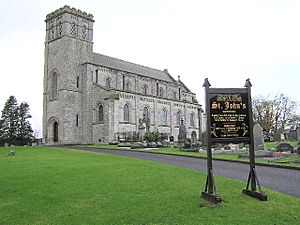Moneymore facts for kids
Quick facts for kids Moneymore
|
|
|---|---|
 St John's Desertlynn Church of Ireland, in Moneymore |
|
| Population | 1,897 (2011 census) |
| Irish grid reference | H8583 |
| District |
|
| County | |
| Country | Northern Ireland |
| Sovereign state | United Kingdom |
| Post town | MAGHERAFELT |
| Postcode district | BT |
| Dialling code | 028 |
| Police | Northern Ireland |
| Fire | Northern Ireland |
| Ambulance | Northern Ireland |
| EU Parliament | Northern Ireland |
| UK Parliament |
|
| NI Assembly |
|
Moneymore (which means "large thicket" or "large hill" in Irish) is a small village and townland in County Londonderry, Northern Ireland. In 2011, about 1,897 people lived there. It's part of the Mid-Ulster District. Moneymore is a good example of a "plantation village." These villages were built by groups like the Drapers' Company from London during a time when new settlements were being created in Ulster.
Contents
Where is Moneymore?
Moneymore is located in a glen, which is a narrow valley. The Ballymully River flows through the southern part of the village. This river starts on a big hill called Slieve Gallion, which is one of the Sperrins mountains and has a radio tower on top. The village is about 35 miles (56.3 km) away from the sea to the north.
Moneymore's Past
A very important battle happened near Moneymore in the year 563. It was called the Battle of Móin Daire Lothair. The Northern Uí Néill group fought against the Cruithin tribe, and the Northern Uí Néill won. This battle was a big deal at the time and is written about in old records called the Annals of Ulster. Many people in Great Britain and Ireland today have ancestors from these groups.
Later, during a period known as The Troubles, there was conflict in Northern Ireland. Sadly, several people were killed in or near Moneymore because of this conflict.
Famous People from Moneymore
Some notable people were born or lived in Moneymore:
- Henry Conwell (around 1748 – 1842) was a Catholic bishop in the United States.
- Richard William Enraght (born 1837) was an Anglican priest known for his strong religious views.
- John Harris (born 1754) was a surgeon and one of the early settlers in Australia.
Cool Places to Visit
One of the most interesting buildings in Moneymore is Springhill. It's a large house from the 17th century, built during the Plantation period. The Conyngham, later Lenox-Conyngham family owned it for a long time. Since 1957, it has been looked after by the National Trust, which protects important places.
You can also visit the Moneymore Model Village. It shows what life was like in rural Ulster during the Plantation time.
Getting Around
Moneymore used to have a train station. It opened on November 10, 1856, but it closed on May 2, 1955.
Sports in Moneymore
- Moneymore GAC is the local club for Gaelic Athletic Association sports, like Gaelic football and hurling.
Schools in Moneymore
Moneymore has two primary schools for younger children:
- Moneymore Primary School (a state primary school)
- St. Patrick's Primary School (a Roman Catholic primary school)
Most older students, who are secondary school age, go to schools in nearby towns like Cookstown or Magherafelt.
Churches in Moneymore
Moneymore has several churches for different Christian faiths:
- St. John's Church (Church of Ireland)
- Church of SS John & Trea (Roman Catholic)
- Moneymore First Presbyterian Church
- Moneymore Second Presbyterian Church
- Moneymore Congregational Church
- Moneymore Gospel Hall
Moneymore's Population
In 2011, the population of Moneymore was 1,897 people. Most residents were from the white ethnic group. About 45% of people were Catholic, and about 50% were Protestant or other Christian. When asked about their national identity, about half felt British, a quarter felt Irish, and nearly 30% felt Northern Irish. A small number of people also had some knowledge of the Irish or Ulster-Scots languages.
See also
 In Spanish: Moneymore para niños
In Spanish: Moneymore para niños


